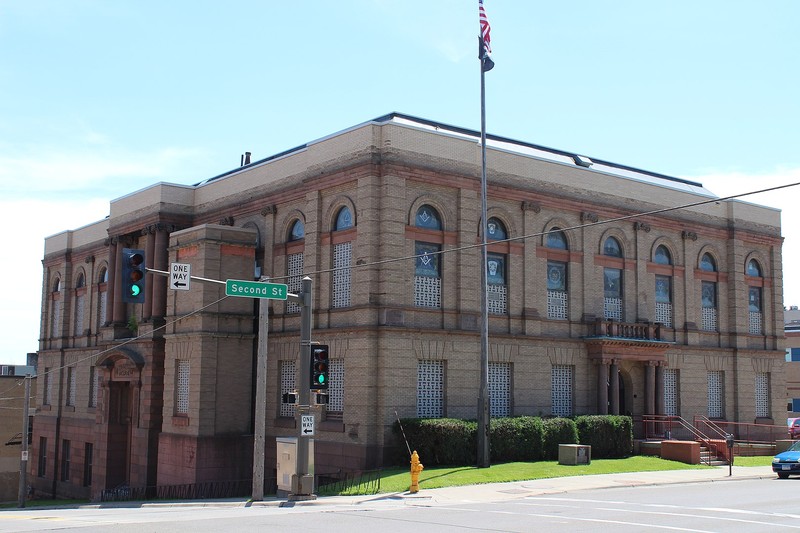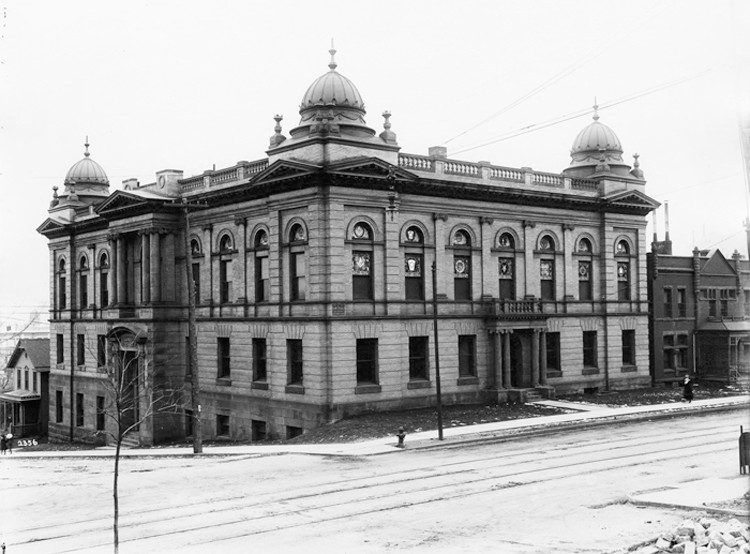Duluth Masonic Center
Introduction
Text-to-speech Audio
Images
2018 Photo of the Duluth Masonic Center

Duluth Masonic Temple in 1910. The domes on the roof were removed during the 1960s.

Backstory and Context
Text-to-speech Audio
The historic Masonic Temple building opened in 1905, but the Masons, who continue to use the building, organized on January 29, 1870, three months before the incorporation of Duluth in March of that year. The original Duluth Masons selected Colonel J. B. Culver to served as the organization's first Grand Master. One month later, the town elected Culver as Duluth's first mayor. Culver served as one example of the numerous members elected to political positions or served as leading business leaders. The Duluth Masons wielded significant power and impact in the city.
Masonic organizations (or Freemasons) have existed as an exceptionally prominent secret society in the U.S. since colonial days. (Masons first organized in England.) George Washington achieved the top grade of the Masons in 1753, and upwards of 21 signers of the Declaration of Independence are believed to have been Freemasons. So influential, in fact, one can find its imagery on U.S. currency; the seeing eye on the pyramid is a Masonic symbol representing the eye of God watching over humanity. During the late nineteenth century, men throughout the U.S. with aspirations of achieving prominent roles within their respective communities routinely became Masons.
From 1870-71 the lodge met on the upper floor of a two-story wood-frame building before moving in 1871 to the third floor of a brick building. Finally, in 1889, the Masons planned and built (completed in 1890) a permanent structure known as Temple Opera Block, which housed the Masonic Temple, an office building, and eventually the Duluth Public Library -- the institution's first home. The Masons also built the Temple Opera House behind the Opera Block, which served as the home to the Mason's Scottish Rite. The Opera House functioned as a theater where Masons performed short, one-act plays that instructed Masons how to work their way through the thirty-three degrees of the Scottish Rite. (For more on Scottish Rite, see the external links found below this backstory.)
A devastating fire in 1895 left the Opera House in ruins. The Temple survived thanks to a firewall between the structures, but the Temple's demise came soon thereafter when financial issues led to its foreclosure in 1896. The Masons spent the next several years regrouping and searching for a facility they no longer had to share. As they waited, several Masons took part in designing and constructing several of Duluth's iconic features.
In 1902, the organization placed Duluth Mason John J. Wangenstein (a Norwegian immigrant) in charge of designing what is now the historic Masonic Temple. All of the subcontractors hired to do work on the building were Masons. When completed in 1905, the Beaux-Arts-style Masonic Temple stood three stories high on its Second Street face and four stories high in the rear. The once prominent domes that adorned the rooftop were removed in the 1960s. The French-pressed brick and red sandstone highlights have mostly disappeared, too. However, the stained-glass windows remain. Additionally, the decorative entrances and columns that allude to the Biblical depiction of King Solomon's Temple have survived.
The Masons enjoyed (and continue to enjoy) a Temple full of ornamentation, extravagant detailing, and motifs inspired by ancient Egyptian and Grecian civilizations. The interior contained a 600-capacity banquet hall, a private a ceremonial room with an altar, and a new, three-story-tall Scottish-Rite auditorium filled with the largest collection of hand-painted drops in Minnesota consisting of such scenes as landscapes, ancient palaces, cathedrals, and religious imagery. The theater installed a pipe organ from Chicago's W. W. Kimball Company in 1908, which allowed the Temple to host public concerts that enjoyed substantial popularity.
Sources
Anderson, Rolf T. "Nomination Form: Duluth Masonic Temple." National Register of Historic Places. nps.gov. December 3, 2014. A digital, achived version can be found at https://web.archive.org/web/20160411012203/http://www.mnhs.org/shpo/nrhp/docs_pdfs/0083_duluthmasonictemple.pdf
Duluth Masonic Center. http://www.duluthmc.org/
Duluth Masonic Temple. Zenith City Press. zenithcity.com. Accessed August 19, 2020. http://zenithcity.com/archive/historic-architecture/duluth-masonic-temple/.
Feuerherd, Peter. "The Strange History of Masons in America." JSTOR Daily. jstor.org. August 3rd 2017. Politics and History sec. https://daily.jstor.org/the-strange-history-of-masons-in-america/.
By Chris857 - Own work, CC BY-SA 4.0, https://commons.wikimedia.org/w/index.php?curid=70156959
Hugh McKenzie, (Image: University of Minnesota Duluth Kathryn A. Martin Library Archives and Special Collections), located digitally at Zenithcity.com: http://zenithcity.com/archive/historic-architecture/duluth-masonic-temple/
